The turbine engine is impossibly alluring. No thrashing pistons, grinding cams, clicking valves-just far fewer exquisitely balanced parts all whirring in the same direction. But turbines are expensive and they guzzle fuel, which means that with very few exceptions, they don’t work we’ll in small airplanes. One of those exceptions is O&N Aircrafts re-engining of the Cessna P210 and 210 with the Rolls Royce (formerly Allison) 250-B17F/2 turbine engine, a powerplant thats been around awhile and one that Rolls is trying to evolve into more GA applications with the advent of a new version, the RR500. Mooney expressed interest in that engine, but thus far, the project hasnt materialized and it may not for the same reasons that turbines have stumbled before: difficult-to-manage fuel specifics and small airframes with no place to put the fuel. Meanwhile, more than 100 of O&Ns Silver Eagle-modified 210s are flying and we recently visited the companys shop in Factoryville, Pennsylvania, to evaluate the mod and do a flight trial. No sugar coating here: The Silver Eagle, at $980,000 complete, is not a cheap mod. On the other hand, its superbly engineered, performs we’ll and has just enough range to make it practical. The 250 engine has proven reliable and relatively easy to maintain. In fact, given its weight and power output, it has significant advantages over the competing engine, Pratts PT6.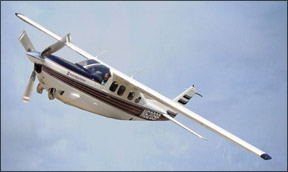
History
This mod is no latecomer, having been perking along since about 1992, when industry veteran Myron Olson made it a signature product of the O&N shop, whose history dates back to 1986. O&N is a general maintenance shop with expertise in the Cessna 210 and P210 models, but with a line of mods including extended-range fuel tanks, control modifications for Cessnas and nacelle wing tanks for Navajos and Senecas.
In order to make turboprop conversions work in light singles, the engine has to meet a narrow set of parameters with regard to weight and fuel consumption. There were only two practical choices, Pratt & Whitneys PT6 and the then-Allison 250, which eventually evolved into the 495-HP 250-B17F/2 when Rolls got hold of it.
For the Silver Eagle, its derated to 450 HP, but thats still a ton of thrust for an airplane that originally had a 310-HP Continental TSIO-520, which some owners complain was never quite up to the task of high-altitude pressurized flight.
The turbine engine was originally developed in the 1960s by Allison as a helicopter powerplant and it found a ready market for that purpose. Like the PT6, its a
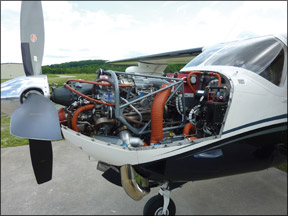
reverse airflow engine, meaning the incoming air makes a 180-degree turn into the combustion section, where it expands to drive a turbine wheel connected to a stub shaft that then drives the prop gearbox.
The 250 series is valued for its small size and incredibly light weight-about 125 pounds dry, plus another 75 for related hardware for a total nose weight of just over 200 pounds. The lightest of the PT6s weigh nearly twice as much. Of course, the weight cuts both ways, since the 250 is lighter than the gasoline engine it replaces, batteries and other gear have to remain forward.
Rolls has evolved the engine to produce better power and efficiency through an improved turbine and burner can, giving as much as 15 percent more power at altitude. That used to be an added cost option, but its now standard.
Most of the Silver Eagle conversions have been performed on P210s, which was manufactured from 1978 to 1986. Of late, to expand the market, Olson told us O&N is starting to convert T210s and normally aspirated models as well. Obviously, these don’t have pressurization, so onboard oxygen is a must. That said, the Silver Eagle does its best in the high teens to low 20s. It doesnt need to get to airline altitudes for speed and economy. Max altitude for the converted P210 is 23,000 feet, but higher with supplemental oxygen. At 23,000, it can maintain a 12,000-foot cabin.
Whats Involved
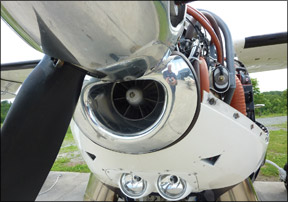
The Silver Eagle mod requires at least three months to complete and when you consider the list of work, its easy to see why. O&N will take an owners 210 or find one on the market and perform the conversion, which is essentially a remanufacture. When we visited the shop a couple of years ago, a 210 was stripped to its underwear and getting new wiring, a landing gear rebuild, air conditioning, a new interior and fresh paint. It gets new heavier vertical and horizontal stab mounts, too, plus reconditioned windows, new glareshield lighting and soundproofing. As required by cert standards, the elevator gets twin trim tabs.
The power quadrant is modified, of course, to replace the throttle/mixture/prop with the traditional turboprop power and condition levers. State-of-the-art avionics are options and lately, says Olson, O&N has been installing Garmin G600 suites with an S-TEC 55X autopilot. The version we flew had the Chelton FlightLogic system. TKS deicing is an available add-on and so are conventional boots driven by a 400-series pump. The engine has plenty of bleed air to blow up the cabin, but cant spare much for deicing.
Because their fuel specifics arent quite as stingy as piston engines, turbines require more fuel…a lot more fuel. Heres where the 250s light weight comes into favorable play.
With the Continental shelved in place of the Rolls, the 210s empty weight decreases by 140 pounds, allowing total tankage-including wingtip add ons and a baggage compartment aux-to total 148 gallons. Most owners, says O&N, opt for both the wingtip and baggage tanks, Allowing for ground idle, climb and descent, thats about 5.5 hours of endurance. That still leaves enough room in the baggage compartment for a moderate amount of stuff. In the airplane we flew, the empty weight was 2699 pounds against a gross of 4016 pounds for a useful load of 1317
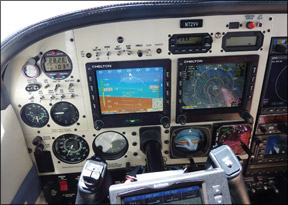
pounds. Full of gas, its two people and light bags.
At cruise speeds typically in the 200-knot range, O&N claims a still-air range of about 1000 miles, which the airplane will do under ideal temperature conditions with a comfortable reserve. But like most turbines, it gives up performance to high and hot, so with wind considered, 800 miles with comfortable reserves might be a better all- around average, unless the wind is pushing.
Flying It
While 310 HP is hardly a piddling amount of power, 450 HP is just a whole hell of a lot better. And it shows immediately on takeoff. When we lined up on Seamans Airports 2500-foot runway, it felt awfully short for something as heavy as a 210. With the power lever forward, however, it was obvious after 50 feet of takeoff roll, 2500 feet is a cakewalk. O&N claims a 600-foot takeoff and although we didnt measure it, we’ll accept that on face value.
Max climb at gross weight is claimed at 2200 FPM and although we didnt see that, the 210 had no trouble loafing along at 1500 FPM, so the climb into the flight levels is typically going to be under 20 minutes, which is a must for milking max range out of the airplane. Although its not sharply fuel limited, it also doesnt have fuel to spare so on long-range flights, pilots want unrestricted climbs to milk the best
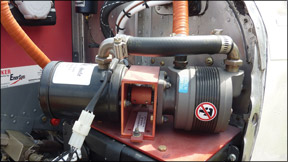
range out the available fuel.
By piston standards, initial takeoff and climb fuel flows are higher, but not insanely so. Olson told us he figures on 32 GPH for the first hour, then 21 to 23 for every hour thereafter. Its not practical to draw the power back to 17 GPH as youd do in a piston aircraft by running lean of peak, so cruise flows are higher.
As youd expect from the higher power, cruise speeds are higher, too, when compared to the Continental-powered P210. Owners tell us they fly the piston version at 175 to 190 knots true, but the Silver Eagle bores along on 210 to 215 knots. The piston version is often described as under-engined, but youd never say that about the Silver Eagle. It has power to spare at any altitude.
But it is temperature limited. For our trial flight with O&Ns Carl Reynolds, we arrived at 17,500 feet in 14 minutes at a cruise climb of 130 knots. The OAT was -5 degrees C, which is ISA +14. Fuel flow was 23 GPH for 180 knots TAS. On a standard day or a colder than standard day, says Reynolds, the airspeed would be as much as 10 knots higher. The engines performance gradient relative to temperature is greater than the true airspeed gain with altitude. Winter cruise speeds in the 220s are doable. Cabin noise is whisper quiet, with no detectable
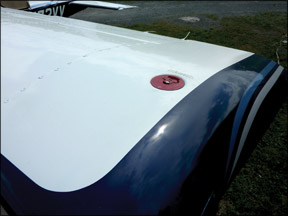
vibration. If you didnt want to wear headsets, you wouldnt need to.
For as fast as it climbs, the Silver Eagle can come down just as fast. Chop the power to flight idle, point the nose over and down you go at 1500 FPM. Not enough? Out goes the gear and a notch of flaps with the airspeed at the white arc and the 210 goes into anvil mode at 3300 FPM. A piston engine might or might not tolerate this abuse, but for a turbine, its just another day at the office. As far as ease of flight, there’s not much to think about-just push the throttle forward and pull it back and keep tabs on the fuel.
If there was any surprise about the Silver Eagle, we would say landing it was the eye opener. Not to put too blunt a point on it, but the 210 is not the lightest pup in the litter when it comes to handling. Its moderately stiff in roll and almost truck-like in pitch. You can one-hand the flare, but it takes effort. It therefore feels like the airplane should approach at a high speed-its not a jet-like 120 knots, but Reynolds recommended 90 knots on final.
Once again, confronted with Seamans 2500-foot narrow runway, it feels like an
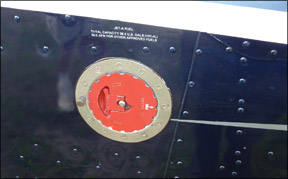
overrun is just two or three knots of excess speed away. Ah, but there’s a method to this madness. Fly short final at 90 knots, slow it toward 80 over the numbers and plop it on the runway. Its a bit graceless, but when you pull the prop past the detent into Beta and stop in 500 feet, you get over that. Its an absolute agita reducer to have the reverse thrust available. Between it and amount of takeoff power available, the Silver Eagle can get into and out of runways where the Super Cubs are parked.
Conclusion
Unless our Berkshire Hathaway stocks pay off beyond our wildest dreams, were unlikely to be able to afford a mod like the Silver Eagle. But we nonetheless concede a fondness for it. Its a nice match of the right size powerplant to an airframe thats not made anymore and that slots it into a unique niche.
Further, O&N is old school, meaning Myron Olson comes from the days when a mod business considered customers as long-term clients, not just one-off opportunities for a sale. Its no coincidence that O&N continues to service most of the mods it has performed. It has also picked up support for the products of one of its competitors, the Tradewind Tubines Bonanzas, which also use the Allison turboprop.
When we visited O&N in June, the company was completing work on yet another conversion-turbines for the popular Cessna 340 pressurized twin. we’ll take a look at that mod in a future issue.

